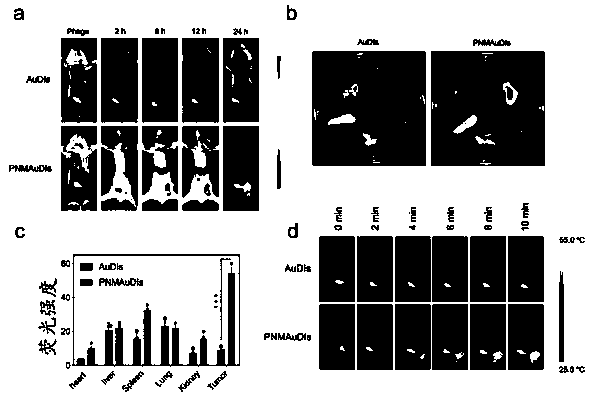Adriamycin-indocyanine green bionic nanoparticles and application thereof
A technology of indocyanine green and biomimetic nanometer, applied in nanotechnology, nanotechnology, nanomedicine, etc.
- Summary
- Abstract
- Description
- Claims
- Application Information
AI Technical Summary
Problems solved by technology
Method used
Image
Examples
Embodiment 1
[0107] Example 1: Synthesis and Characterization of Doxorubicin-Indocyanine Green Biomimetic Nanoparticles Coated with Platelet Membrane
[0108] AuDIs as the inner core were obtained by using gold nanocages (0.1 mg mL -1 ) and DOX (0.05mg mL -1 ) and ICG (0.05mg mL -1 ) were prepared by incubating with stirring at room temperature for 36 hours. The final mixture was centrifuged at 16000 g for 25 min and washed with PBS to remove residues of DOX and ICG. Similar treatment was used to prepare AuDs or AuIs with / without DOX or ICG.
[0109] After platelet-rich plasma was anticoagulated with EDTA, red blood cells were removed by centrifugation at 100g for 20 minutes, the supernatant was added to prostacyclin to inhibit platelet activation, centrifuged at 800g for 20 minutes, and resuspended in PBS containing protease inhibitors. Platelet membranes were prepared by repeated freezing and thawing. Platelets were quickly frozen in liquid nitrogen and dissolved at room temperature...
Embodiment 2
[0113] Example 2: Effects of PNMAuDIs on 4T1 cells
[0114] Confocal microscopy was used to examine cellular internalization of PNMAuDIs. 4T1 cells were incubated with PNMAuDIs, NMAuDIs, PMAuDIs, ICG and DOX with / without laser irradiation for 6 h, respectively. As shown in Figure 3a, green ICG fluorescence was found in the cytoplasm, while red DOX fluorescence was found in the nucleus. In 4T1 cells, PNMAuDIs plus laser irradiation showed the strongest intracellular fluorescence of ICG and DOX, indicating that the higher affinity of interacting receptors improves the cellular uptake of PNMAuDIs ( image 3 b). To examine the photothermal efficiency of PNMAuDIs, temperature changes were recorded. Laser irradiation via a thermal imaging camera. When at 1W·cm -2 When exposed to laser light for 5 min, the temperature of saline, ICG, AuDIs and PNMAuDIs increased to 30.2, 50.3, 57.3 and 58.1 °C, respectively. In ICG solution, a lower temperature exists compared with AuDIs due to...
Embodiment 3
[0116] Example 3: The ability of PNMAuDIs to bind exosomes in vitro
[0117] Recent reports have shown that tumor-derived exosomes are critical to the invasion-metastasis cascade. Among them, exosomes enable uncontrolled disease progression, promote a niche for cancer growth and suppress immune cell function. To explore the binding ability of exosomes to PNMAuDIs, exosomes were stained with DiO, and platelet and neutrophil membranes were prelabeled with DiD. Confocal was used to explore the interaction between PNMAuDIs and exosomes. Such as Figure 4 In a, NMAuDIs, PMAuDIs, and PNMAuDIs were incubated with exosomes, among which all PNMAuDIs were the most co-localized. In addition, co-localization was observed and demonstrated by electron microscopy ( Figure 4 b). The increase in particle size and decrease in zeta potential also confirmed the co-localization of PNMAuDIs and exosomes, possibly due to the similarity of membrane proteins between tumor cells and tumor-secrete...
PUM
 Login to View More
Login to View More Abstract
Description
Claims
Application Information
 Login to View More
Login to View More - R&D
- Intellectual Property
- Life Sciences
- Materials
- Tech Scout
- Unparalleled Data Quality
- Higher Quality Content
- 60% Fewer Hallucinations
Browse by: Latest US Patents, China's latest patents, Technical Efficacy Thesaurus, Application Domain, Technology Topic, Popular Technical Reports.
© 2025 PatSnap. All rights reserved.Legal|Privacy policy|Modern Slavery Act Transparency Statement|Sitemap|About US| Contact US: help@patsnap.com



